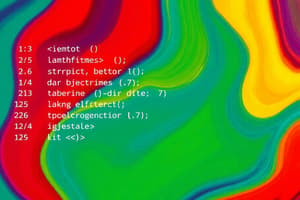Podcast
Questions and Answers
What is a member function in object-oriented programming?
What is a member function in object-oriented programming?
- A function that performs arithmetic calculations
- A function that represents an operation and is part of a class (correct)
- A function that is used to print output to the console
- A function that is declared globally and can be accessed from any class
Which section of the program typically contains the member function definitions?
Which section of the program typically contains the member function definitions?
- Private section
- Main function
- Public section (correct)
- #include section
What is the purpose of the 'setRadius' member function in the given code?
What is the purpose of the 'setRadius' member function in the given code?
- To calculate the circumference of the circle
- To set the radius of the circle to a specific value (correct)
- To find the area of the circle
- To check if the radius is valid
What happens if the 'getPerimeter' member function is called before setting the radius of a Circle object?
What happens if the 'getPerimeter' member function is called before setting the radius of a Circle object?
In object-oriented programming, what is a common way to ensure encapsulation?
In object-oriented programming, what is a common way to ensure encapsulation?
What is the primary purpose of access modifiers in a class?
What is the primary purpose of access modifiers in a class?
Which of the following statements accurately describes the role of constructors in a class?
Which of the following statements accurately describes the role of constructors in a class?
What is the primary purpose of the this pointer in C++?
What is the primary purpose of the this pointer in C++?
Which of the following statements accurately describes the relationship between a class and an object?
Which of the following statements accurately describes the relationship between a class and an object?
What is the primary purpose of destructors in a class?
What is the primary purpose of destructors in a class?
Flashcards are hidden until you start studying
Study Notes
Classes and Objects
- A type is an abstraction from which instances are created, allowing multiple instances from a single type.
Classes and Instances
- A class represents a user-defined type.
- An object represents an instance of a class.
Attributes and Behaviors
- An attribute is a characteristic of an instance (e.g., Weight).
- A behavior is an operation that an instance can perform (e.g., Run).
Class Definition
- A class definition consists of data members (variables) and member functions (functions).
- Data members represent attributes, and member functions represent operations.
Class Example: Circle
- The Circle class has a private data member: radius.
- The Circle class has public member functions: setRadius, getRadius, getArea, and getPerimeter.
Member Functions
- Member functions can be defined inside or outside the class definition.
- setRadius is a member function that sets the radius of the Circle object.
- getRadius, getArea, and getPerimeter are member functions that return the radius, area, and perimeter of the Circle object, respectively.
Access Modifiers
- Private access modifier: variables or functions can only be accessed within the same class.
- Public access modifier: variables or functions can be accessed from anywhere.
Instantiation
- Creating an object from a class is called instantiation.
- Creating multiple objects from a class is possible, and each object has its own set of attributes and behaviors.
Studying That Suits You
Use AI to generate personalized quizzes and flashcards to suit your learning preferences.





